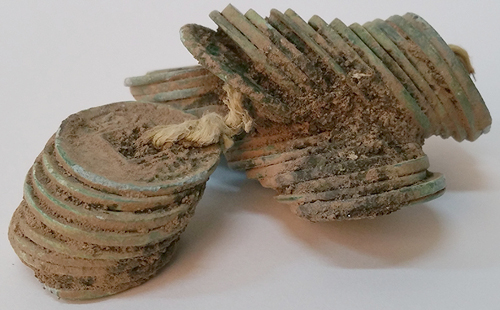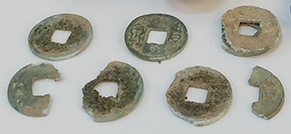More than fifty Chinese coins cast 2,000 years ago during the reign of Wang Mang of the Xin Dynasty were recently discovered in a tomb in Gwangju, South Korea according to Korean and Chinese news reports.
The discovery is particularly notable since Korea did not begin using or casting its own coins until some 900 years later during the Koryo Period (高麗 936-1392).

Chinese huo quan coins found in Korean tomb
As can be seen in the image above, the coins have the Chinese inscription 貨泉 (huo quan; 화천 hwacheon). Huo quan coins were cast during the years AD 8-23 of the reign of Wang Mang of the Xin Dynasty.
The bundle of coins was discovered in a rectangular togwang-myo, or earthen tomb, next to a short-necked jar and 78 pieces of blue glass-jade beads.

Some of the more than fifty huo quan coins recovered from the tomb
The announcement on January 18, 2016 by the Research Center of Dolmens in Northeast Asia indicates that the tomb is located in Gwangju, Jeollanam-do Province in the southwest of South Korea.
A total of nineteen huo quan coins had previously been found scattered among various ancient ruins in Korea but this is the first time that such coins had been discovered in a tomb.
The book “Money, Traditional Korean Society” by Won Yu Han mentions that one of these ruins where coins from the Xin (Hsin) Dynasty had previously been found is on Jeju Island.
Jeju Island is dear to my heart because I was a Peace Corps volunteer there from 1972 to 1974 working in a tuberculosis control project.
Most of the coins found in the tomb have a diameter of 2.2 – 2.3 cm although some are as large as 2.6 cm.
The announcement by the Research Center of Dolmens in Northeast Asia concludes that the discovery of Xin Dynasty coins around the Yeongsan River and along the southern coastal regions of South Jeolla Province is evidence that maritime trade routes with the Xin Dynasty existed at the time.